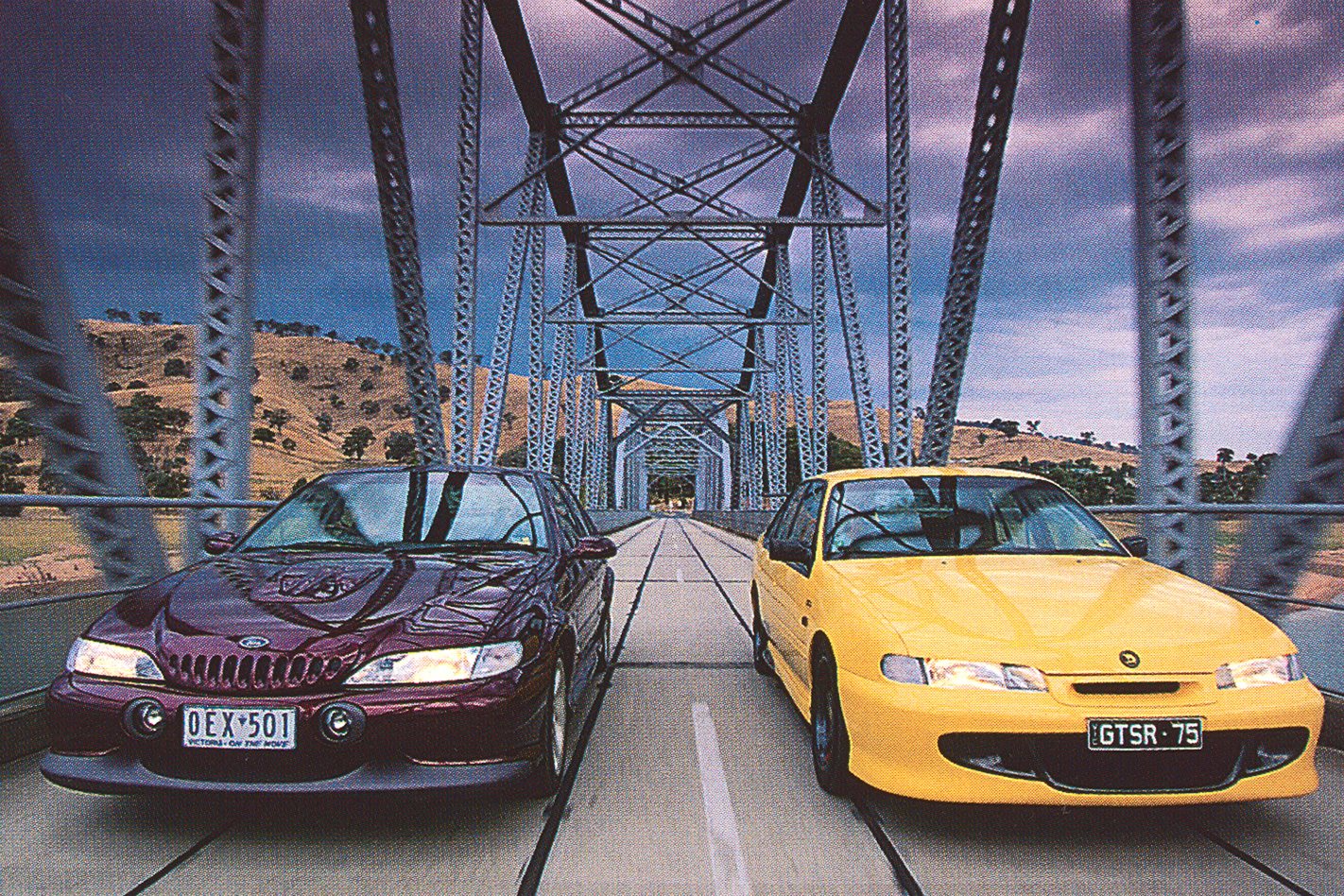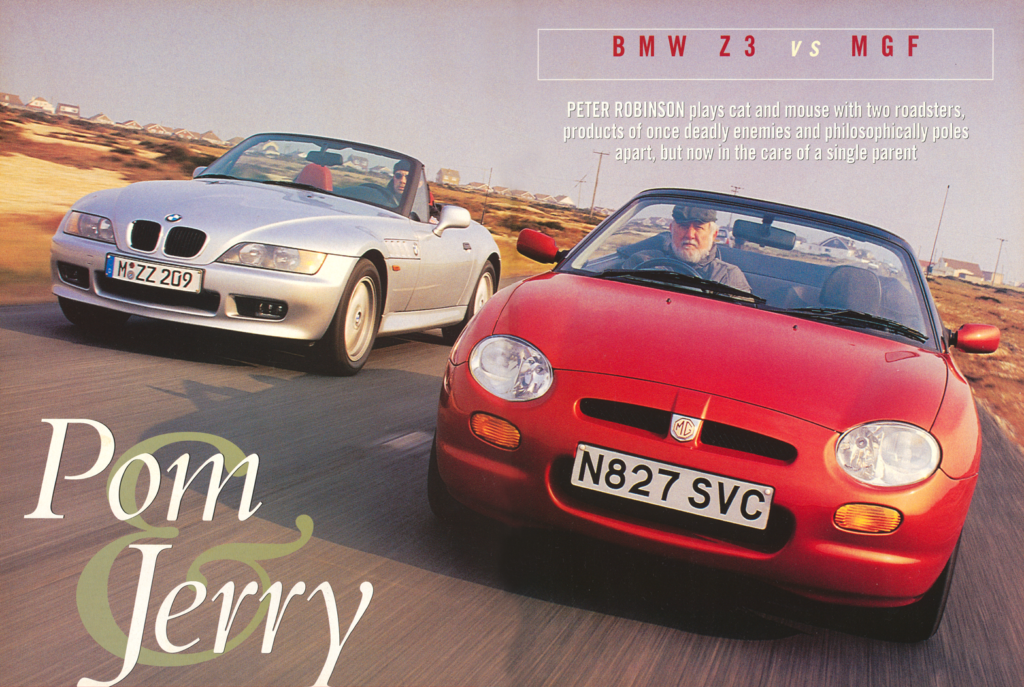This is the moment we’ve been waiting for – HSV’s big-bang banana against Ford’s awesome aubergine! Todd Hallenbeck chows down…
First published in the April 1997 issue of Wheels magazine, Australia’s most experienced and most trusted car magazine since 1953.
Two highway patrolmen at an RBT, one with blowmeter in hand, the other with a clipboard pointed me to the kerb. The GTS-R pulled up behind. Their reaction to the Falcon GT was unexpected if not unbelievable. “Your driver’s license, please,” said one cop while the other circled to the front and squared up looking at the nose. He then penned something down. – “Blow in the white tube until I say OK.
” Blow. .. blow … blow … “OK. Thank you; you can go;’ he said politely. I waited a long second to give him time to phrase the inevitable, obvious question. Here was a man whose job required him by law to be ultra-observant. I don’t doubt that he could spot the gender of a fly at ten paces. He must have spotted the GT’s unique grille, the twin bonnet-vent nostrils, the rear wing, the wheels. The waiting became loitering. How long would it take?
This is it, according to Ford. The big three zero party on wheels, the best Falcon ever built, the GT of GTs! Check the power and acceleration stats, says Ford, and you’ll see that this is the quickest, best handling GT Ford Australia has ever built. History was about to happen as I watched the cops’ reaction to Ford’s masterpiece.
He and partner ignored the GT and walked to the yellow GTS-R. “Your driver’s license, please.” Before Adam Porter could pull his wallet, the same patrolman asked: “So what does it go like? Do you mind if I have a look under the bonnet.”
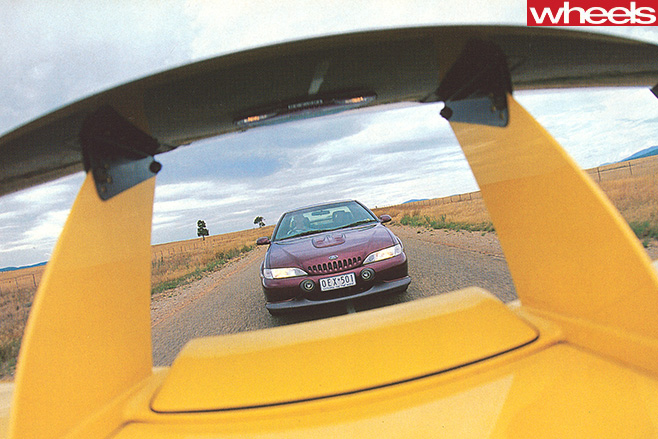
In other quarters, reaction to the GT has been anything but calm. “It is the worst facelift that’s ever been done in Australia,” said one ex-GM designer. “It’s wrong,” said another. The editor of this magazine said, “The styling, er, grows on you.”
But Marty, a graphic designer, said, “I think it looks cool. It’s so totally different.”
Steve Park, head of design at Ford Australia, walked backwards from the nose and lowered himself to grille height. “You have to give it the 50 metre test,” he said. “We went for a strong down-the-road graphic and when you see the front end in the rearview mirror, it has impact.”
Very true. Nothing fills the mirrors like the front of an Ford Falcon EL GT at optimal distance; however, at a distance greater than the prescribed 50 metres, the dark front end begins to rapidly lose impact and it slowly morphs into a VB Commodore-ish shape.
“It is as aggressive as we could get it,” stressed Park. And the grille? “I have no problems with it being a controversial part of the car.”
Amid the controversial look, there are reminders of the EB GT (designed by Paul Gibson in the UK) in the wheel arch extensions, along the flanks and over the boot.
At the rear, the EL’s wing is bigger than the EB’s but not nearly as big as Park initially drew it. Apart from downsizing the wing, Park needed only to complete a few renderings and one tape drawing before progressing the design to full-sized clay.
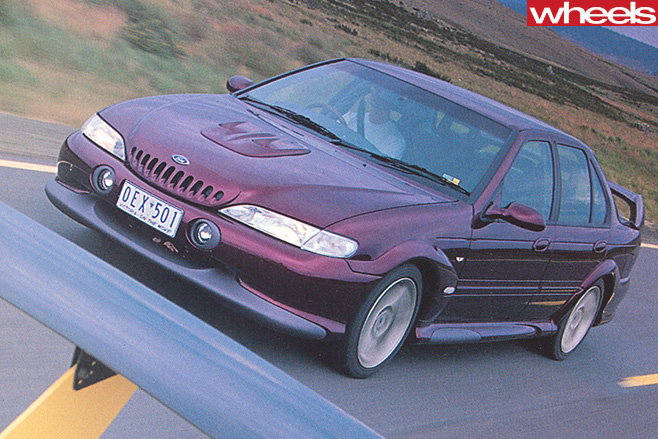
And Tickford paid careful attention to controlling air intake for another reason: cooling the 5.0 litre Windsor. Fresh air enters under the front spoiler’s raised lower lip to pass through the radiator and aircon condenser; and exit through the bonnet vents.
The unique GT two-post wing also serves a performance function. “The wing is an inverted aerofoil section,” says Ford Motorsport Manager Greg Harbutt. “It generates downforce in a similar way to a Group A wing.” Tested in Monash University’s full-sized wind tunnel, the wing decreases lift at the back of the car by 70 percent. The wind tunnel also showed the bonnet vents are optimally placed in a low-pressure area.
It is interesting to note that Ford didn’t use the XR series headlights. Instead, the GT sees through stock Fairmont lamps and, with the addition of two, low-mounted SSW driving lights, the GT throws a wide, intense high beam.
Whether or not you like the grille, there is heritage in much of Park’s design. He purposefully picked up traditional GT cues, such as the driving lights, bonnet vents, and rear wing to reinforce the GT’s performance. A Falcon GT is special; it is more than a warmed XR8, it is a GT. And, says Marsden, “It is a GT in the style of grand touring car. Not a Phase III.”
Tickford boss David Flint interrupts: “There is a market for a balls-out, all-power Falcon, but not a GT.” Flint doesn’t press the point, and Marsden adds that they looked at using a 351 Windsor in the EL GT only to be prevented by the Falcon’s limited underbonnet real estate.
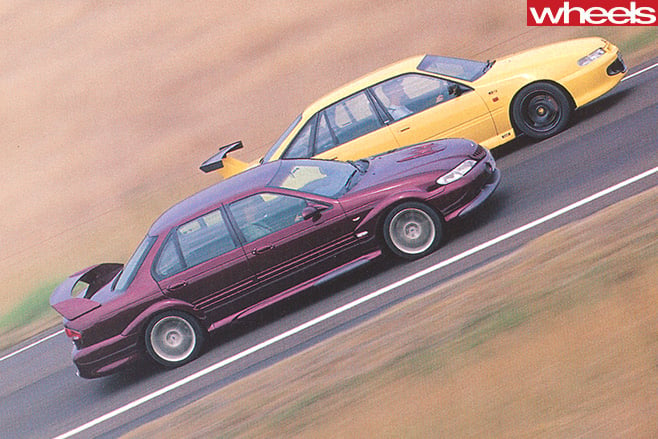
Those that can afford the $69,500 asking price expect comfort, a degree of individuality and a high level of refinement, and the GT doesn’t disappoint. The bucket seats are skinned in charcoal leather with grey suede accents carried across to the door trims and armrests. Both front door trims are marked with a GT badge. Real wood and woodgrain fascia trims offset the leather at the gearknob, steering wheel and along the upper door trims.
A leather/wood Momo steering wheel accommodates airbag and cruise controls. Still within the comfortable surrounds, the GT’s performance edge is not far away, with the speedo face reading to 240km/h (standard Falcon reads to 220).
“Those few numbers cost us a lot,” says Flint.
The $1.5 million development cost (which Flint admits was closer to $2m) went mostly on upgrading the ride and handling, but the bodywork wasn’t cheap and neither was the job of enlivening the hardy old 5.0 litre V8 Windsor.
Producing the required 200kW meant Tickford had to make the 5.0 litre breathe more efficiently. On intake, the mass-produced, cast-alloy manifold was changed for a high-flow mandrel-bent tube manifold accompanied by a 65mm air-mass throttle body and a pair ofGT40 cast-iron heads with 47mm intake (from 45mm standard) and 39mm exhaust valves.
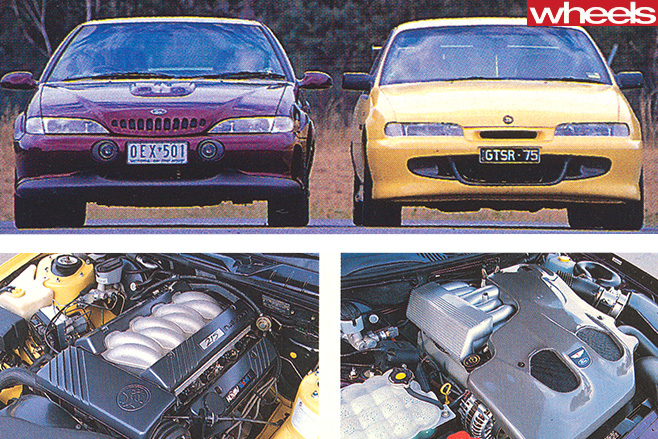
Colour choice is limited to three dark metallics from the Fairmont’s palette: Sparkling Burgundy, Heritage Green and Navy Blue. We’d hoped for gold to commemorate the XR GT and expected black, which was the most popular colour choice on EB GT. Offering the two custom colours would have required Ford to go outside its Falcon colour loop, a option that wasn’t financially viable.
Alongside HSV’s taxi-yellow GTS-R, the GT’s quiet colour lacks impact and falls short of giving the 272 limited-run of EL GTs visual distinction. Looking at the dark metallics, you wouldn’t know the EL GT is a statement of Ford Australia’s performance heritage. It blends with traffic while the GTS-R bounces out of it like a hyperactive B1 or B2.
There are greater differences to compare here.
The GTS-R, based on a Commodore Executive, skimps on the frills and can’t match the GT’s high level of interior trim or refinement. HSV shows its marketing savvy by using existing components and maximising model distinction with colour and performance hardware. The GTS-R’s few body pieces are off-the-shelf GTS/Senator accented with licks of paint and carbon-fibre. In one swoop, the GTS-R’s high-standing Group A wing more effectively delivers hardcore confirmation that it is a performance car than does the GT’s 11 body bits. Also to HSV’s advantage, it doesn’t reinvent the performance car every five years.
Selling 272 GTs is a no-brainer for Ford. “It will sell,” insists marketing and sales manager Roger Clarke. He’s more reserved when asked whether the GT badge will become an annual.
To Tickford, the GT is a new pair of fuzzy dice. “It’s my way of showing my boys’ engineering skills,” says Hint. “Everything on this car has been chosen to perform better than EB GT.” Apples to apples, there’s no contest; so we brought along a banana.
The GTS-R is pure boy racer. No apologies, no excuses, no holds barred. The GTS-R is the quickest and fastest Australian car ever built, according to HSV. HSV’s own figures claim the quarter mile in 14.4sec (equal to Ford’s GT HO Phase III) and a speed needle reading of240km/h+. Feats we’ve never duplicated.
Saturday morning, we ran the Snowy Mountain highway that links Adelong to Tumut to Kiandra to Adaminaby. The road is smooth and fast with long, sweeping, constant radius turns. The road climbs and falls like corrugated tin through Kosciusko National Park. GT country that’s exhilarating to drive and distracting to look at, and perfect for the two torque-heavy V8s. From 5.0 litres, Tickford is claiming 420Nm at 3700rpm on a curve that bends by only 70Nm from 1500rpm to 5250rpm. HSV’s 5.7litre Holden V8 tugs out 507Nm at 3600rpm.
The GTS-R sits the driver low in the cockpit and snugs him in with a proper seat. Without turning a wheel, one complaint echoed by everyone who drove the GTS-R concerned the car’s long-action clutch pedal. It’s stiff but that’s not such a problem as the distance it must be pushed.
The GT props the driver taller in the seat; clutch to brake to throttle placement is spot-on, and pedal action is succinctly matched to the five-speed manual transmission’s action. The GT’s controls work more in harmony with the driver, though the seat could use more rearward travel.
The GT’s ride is firmer, slightly bouncier and less darty. In raw roadholding, it has the upper hand, but the GTS-R plays more confidently on the edge. Slipping a toe over isn’t alarming and is easily controlled with the right foot and 507Nm armed and ready.
The GTS-R ‘s front end is more compliant and less responsive than the GT’s, and when it lets go, it goes gradually and recovers quickly.
The GT does the opposite. It never breaks loose at the front, preferring instead to lean hard on the outside rear tyre. Marsden claims the Yokohama A510 245/40 rubber performs better than European rubber, and allowed chassis/ suspension engineer Steve Hoinville, with input from John Bowe, to hone the GT’s handling.
The GT, exceptionally well balanced and with direct steering response, is the best handling Falcon ever.
We won’t get too gushy with deserving praise without saying the GT feels hundreds of kilos lighter than its 1668kg (1698kg with automatic).
Not only is it as agile as a cat on carpet through turns, it plants hard and firmly pushes off the apex with bags of Newton-metres from the free-revving V8.
Hopefully, Tickford’s modifications will trickle down to XR6/8 series and eventually base-model Falcon. Front springs are 10Nm firmer than XR8’s 69Nm rates, front antiroll bar is 28mm (the largest previously used is 27mm).
Marsden says: “The reasonably stiff front end allowed the [rigid axle] rear to work better.” The one negative is noticeable tyre noise, especially when riding in the rear seat. “Out of all the positives of the Yokohamas, we’re comfortable with that one negative,” says Marsden.
Australian to its big DBA-developed disc brakes and two-spot calipers and its 17×8.5 ROH-designed alloy wheels, the GT is not just an engineering triumph for Tickford. BTR specifically developed a Hydratrak LSD for the rigid axle suspension that transfers 20 percent higher torque loadings than the Hydratrak LSD in the GTS-R’s independent rear.
Kelray worked in pocket with Tickford to tailor-make the GT’s urethane suspension bushes, and BTRE debuts its five-mode adaptive automatic transmission as well as supplying the gears for the manual five-speed gearbox. The only imported bits are engine, tyres, optional sunroof, steering wheel and clutch.
If A to B involves a few turns, the GT outpaces the GTS-R. Toss a detailed road map in the GT’s glovebox because its skills are a terrible thing to waste cruising down some boring freeway.
In a straight line, as hard as we tried, neither equalled the manufacturer’s acceleration claims.
Hot, humid air, a passenger and a full fuel tank were perhaps the reasons.
At best the GTS-R was almost a second off HSV’ s 14.4sec 400 metre time, and the GT never came close to Ford’s claim of6.97sec 0- 100km/h sprint and 15.06sec standing 400 metres. Our quickest, 3500rpm dump-the-clutch pass returned 8.08sec and 15.76sec.
Don’t fret, we have very good insider information that the GT is quickest with 20,000km on the counter. It is a driver’s car, after all.
| u00a0 | FORD FALCON GT | HSV GTS-R | ||||
| PRICE | ||||||
| Basic | $69,000 | $75,000 | ||||
| u00a0 | u00a0 | u00a0 | u00a0 | u00a0 | u00a0 | u00a0 |
| ENGINES | ||||||
| Layout | longitudinal V8. ohv, 16v | longitudinal V8, ohv, 16v | ||||
| Induction | multi-point fuel injection | multi-point fuel injection | ||||
| Capacity (litres) | 4.942 | 5.737 | ||||
| Bore and stroke | 101.6 and 76.2mm | 101.6 and 88.4mm | ||||
| Compression ratio | 9.0:1 | 8.5:1 | ||||
| Maximum power | 200kW at 5700rpm | 230-235kW at 4800rpm | ||||
| Maximum torque | 420Nm at 3700rpm | 507Nm at 3500rpm | ||||
| Redline/cut-out | 5500/6200 | 5500/5700 | ||||
| u00a0 | u00a0 | u00a0 | u00a0 | u00a0 | u00a0 | u00a0 |
| TRANSMISSIONS | ||||||
| Ratios (km/h per 1000rpm) | 5 speed manual | 6 speed automatic | ||||
| First | 2.95(11.2) | 2.66 (12.7) | ||||
| Second | 1.94 (17.1) | 1.78 (19.0) | ||||
| Third | 1.34 (24.7) | 1.30 (26.0) | ||||
| Fourth | 1.00 (33.1) | 1.00 (33.8) | ||||
| Fifth | 0.73 (45.4) | 0.74 (45.7) | ||||
| Sixth | u00a0 | 0.50 (67.7) | ||||
| Differential ration | 3.45 | 3.45 | ||||
| u00a0 | u00a0 | u00a0 | u00a0 | u00a0 | u00a0 | u00a0 |
| SUSPENSION | ||||||
| Front: | short and long arm, coil springs, anti-roll bar | struts, coil springs anti-roll bar | ||||
| Rear: | Walls linkage, coil springs, anti-roll bar | independent, semi-trailing arms, coil springs, anti-roll bar | ||||
| Tyres: | 245/40R17 91 V Yokohama A510-40V | 235/45ZR17 B’stone Expedia S-01 | ||||
| u00a0 | u00a0 | u00a0 | u00a0 | u00a0 | u00a0 | u00a0 |
| BRAKES | ||||||
| Front: | vented discs, ABS | vented discs, ABS | ||||
| Raear: | discs | discs | ||||
| u00a0 | u00a0 | u00a0 | u00a0 | u00a0 | u00a0 | u00a0 |
| STEERING | ||||||
| Steering type | power assisted, rack and pinion | power assisted, rack and pinion | ||||
| Turns lock to lock | 2.8 | 2.7 | ||||
| Turning circle | 11.1m | 11.0m | ||||
| u00a0 | u00a0 | u00a0 | u00a0 | u00a0 | u00a0 | u00a0 |
| VITAL STATISTICS | ||||||
| Wheelbase | 2791mm | 2735mm | ||||
| Front track | 1566mm | 1485mm | ||||
| Rear track | 1547mm | 1485mm | ||||
| Length | 4931mm | 4861mm | ||||
| Width | 1888mm | 1782mm | ||||
| Height | 1394mm | 1420mm | ||||
| Weight | 1668kg | 1620kg | ||||
| Fuel tank | 68 litres | 80 litres | ||||
| u00a0 | u00a0 | u00a0 | u00a0 | u00a0 | u00a0 | u00a0 |
| PERFORMANCE | ||||||
| Speed in gears, km/h at rpm | ||||||
| First gear | 61 at 5500 | 70 at 5500 | ||||
| Second gear | 94 at 5500 | 105 at 5500 | ||||
| Third Gear | 136 at 5500 | 143 at 5500 | ||||
| Fourth gear | 182 at 5500 | 186 at 5500 | ||||
| Fifth gear | 234 at 5150 | 246 at 5400 | ||||
| Sixth gear | u00a0 | 216 at 3300 | ||||
| Standing start, time in seconds | ||||||
| 0-60km/h | 3.8 | 3.3 | ||||
| 0-80km/h | 5.5 | 5.2 | ||||
| 0-100km/h | 8.1 | 7.5 | ||||
| 0-120km/h | 10.9 | 10.1 | ||||
| 0-140km/h | 15 | 13.6 | ||||
| 0-160km/h | 20.1 | 18 | ||||
| 0-400m (km/h) | 15.8 (143.9) | 15.3 (148.6) | ||||
| Overtaking | ||||||
| u00a0 | 3rd | 4th | 5th | 3rd | 4th | 5th |
| 40-70km/h | 4.0 | 5.3 | 8.0 | 3.7 | 4.8 | 7.2 |
| 60-90km/h | 4.0 | 5.2 | 8.0 | 3.5 | 4.8 | 7.3 |
| 80-110km/h | 4.0 | 5.2 | 8.5 | 3.5 | 4.6 | 7.6 |
| 100-130km/h | 4.7 | 5.3 | 10.0 | 4.0 | 4.6 | 8.4 |
| u00a0 | u00a0 | u00a0 | u00a0 | u00a0 | u00a0 | u00a0 |
| FUEL CONSUMPTION | ||||||
| Best | 11.0 L/100km (25.6mpg) | 9.1 L/100km (31.0mpg) | ||||
| Worst | 18.4 L/100km (15.4mpg) | 17.7 L/100km (16.0mpg) | ||||
| Average | 15.3 L/100km (18.5mpg) | 14.9 L/100km (19.0mpg) | ||||

